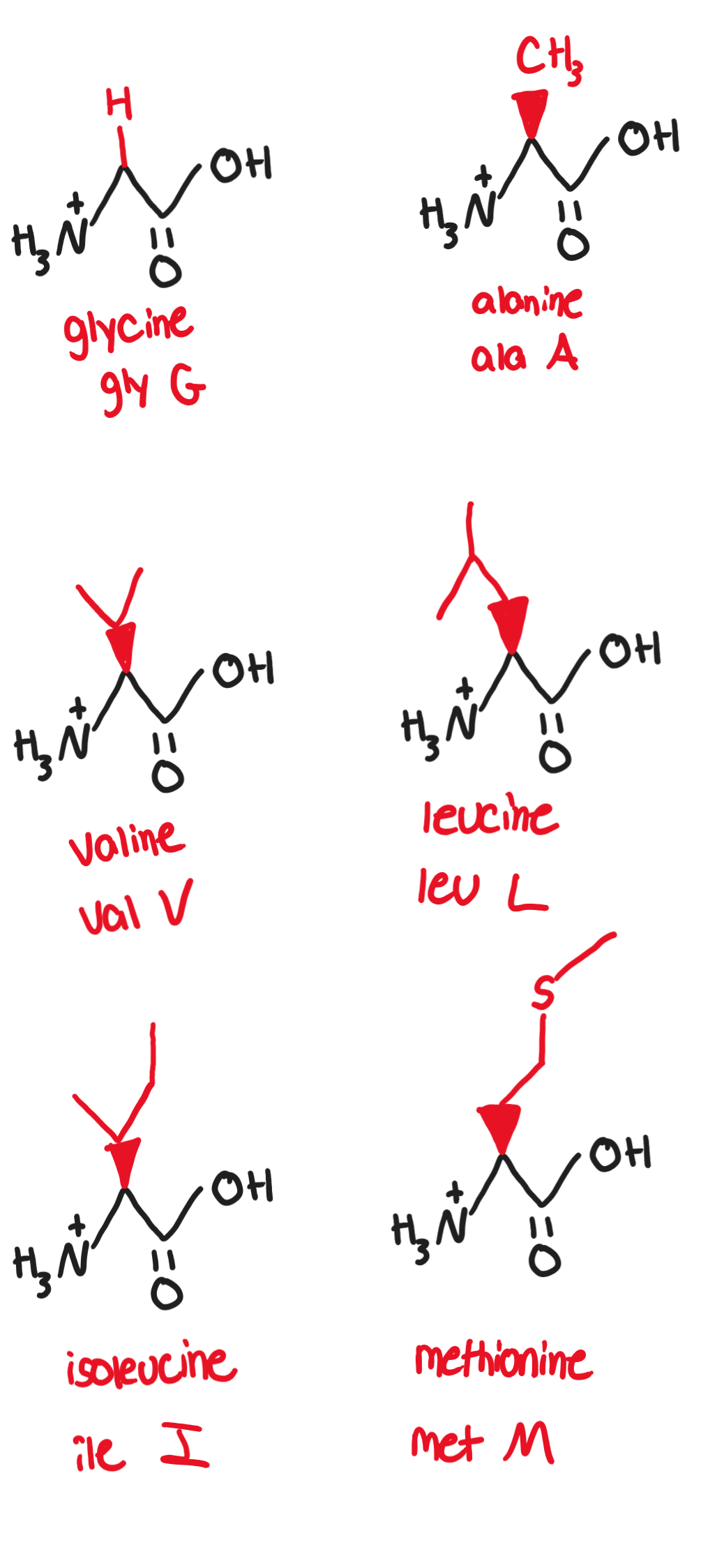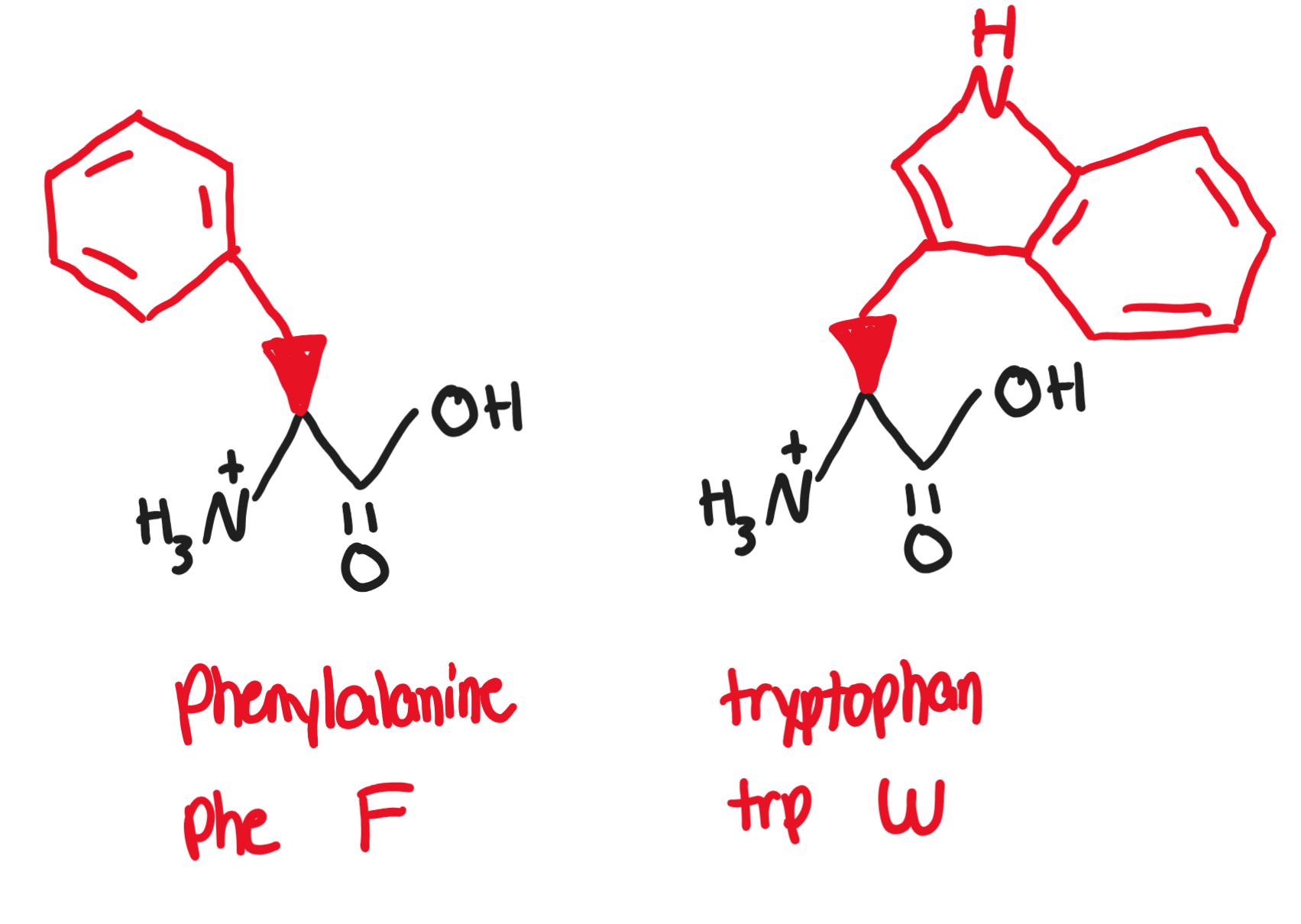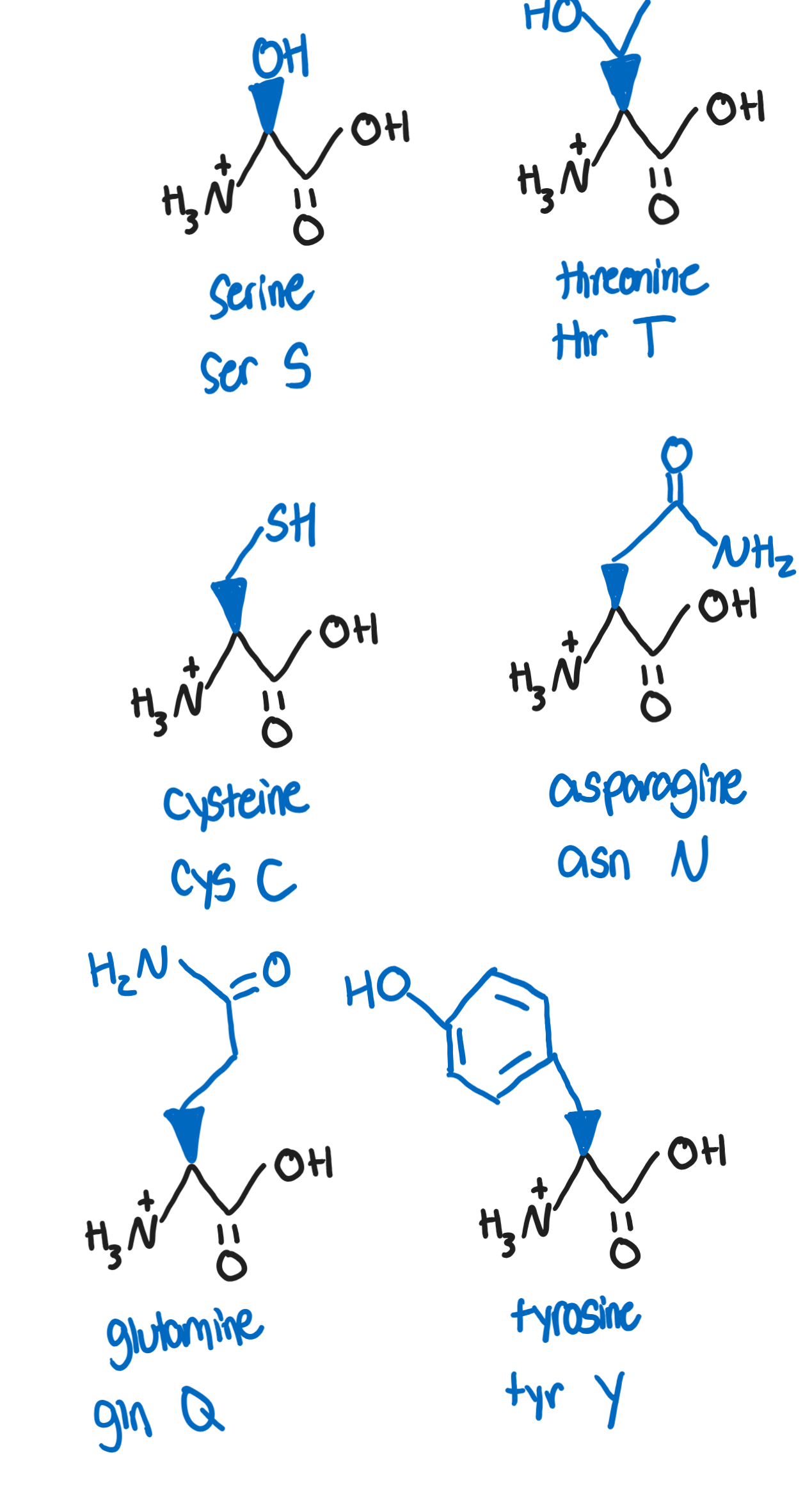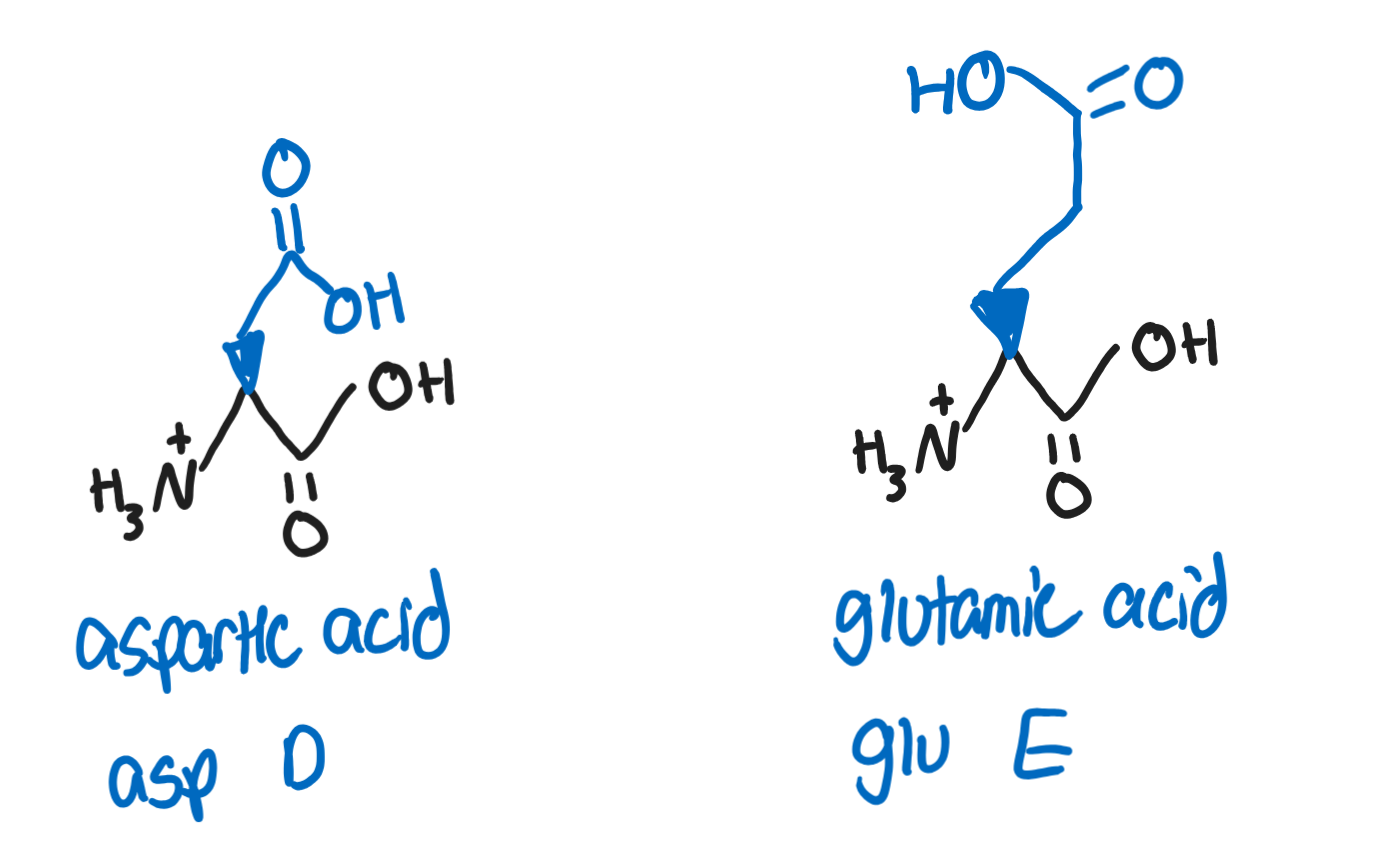
Amino Acids and Proteins (copy)
Proteins are linear heteropolymers of alpha-amino acids
Amino acids share many features, differing only at the R substituent (group)
the alpha carbon is chiral when the R group is anything other than hydrogen (so anything other than glycine)
all chiral amino acids are optically active
Because of tetrahedral arrangement of bonding orbitals around the alpha-carbon, the four different groups can occupy two unique spatial arrangements and thus have 2 possible stereoisomers: L and D
L and D versions of an amino acids are enantiomers
nonsuperimposable mirror images
only L-amino acids are found in proteins
Amino acids are classified based on their R groups (charge, H-bonding ability, and if they’re acid/basic)
Two main categories: Hydrophobic and Hydrophilic
Hydrophobic amino acids are non-polar (includes AA’s with alkyl/aliphatic and with aromatic R groups)
Hydrophilic amino acids are polar, includes neutral, acidic, and basic R-groups
Non-polar side chains consist mostly of hydrocarbons
any functional groups are uncharged at biological pH
Glycine, Gly, G (-H)
only achiral amino acid, has a slightly sweet taste
Alanine, Ala, A (-CH3)
canonical example of a simple. small, nonpolar amino acid
Proline, Pro, P (R-group is a ring, bonds with amino group twice)
can break up secondary structures due to the kink proline can cause
can be found within the turns of beta-pleated sheets
Valine, Val, V (-CH(CH3)2)
it substitution for glutamic acid in hemoglobin causes sickle-cell disease
contains isopropyl group
Leucine, Leu, L (-CH2CH(CH3)2)
essential amino acid (animals and humans cannot synthesize it ourselves so it must be obtained from diet)
Isoleucine, Ile, I (-CH(CH3)CH2CH3)
essential amino acid
Methionine, Met, M (-CH2CH2SCH3)
C-S bond makes molecule nonpolar, involved in DNA methylation and angiogenesis
essential amino acid found especially in eggs

Aromatic R-groups can absorb UV light
the higher the concentration of protein in a substance, the more UV light is absorbed
Phenylalanine, Phe, F (-CH2-benzene)
present in artificial sweetener aspartame
Tryptophan, Trp, W (two rings)
precursor of serotonin and melatonin

side chains are hydrophilic, thus on surface of proteins and are subjected to chemical modifications
can be oxidized or reduced, affecting conformation of protein
Serine, Ser, S (-CH2OH)
target for phosphorylation and other processes involved in post-translational modifications and signaling (due to OH group)
Threonine, Thr, T (-CH(OH)CH3)
target for phosphorylation due to OH groups
essential amino acid
Cysteine, Cys, C (-CH2SH)
can form covalent disulfide bridges (important in tertiary structures)
Asparagine, Asn, N (-CH2(CO)NH2)
reacts to reducing sugars (glucose and fructose) in baked and fried foods to form acrylamide, a potentially carcinogenic compound
Glutamine, Gln, Q (-CH2CH2(CO)NH2)
most common as a free-amino acid in human blood and is involved in a wide range of metabolic reactions
Tyrosine, Tyr, Y (CH2-benzene-OH)
can undergo post translational modifications and phosphorylation
aromatic

Lysine, Lys, K (-(CH2)4NH3+)
the primary amine at the end of the chain is fairly reactive and is the target for many covalent modifications (methylation and acetylations)
Arginine, Arg, R (-NHC(NH2+)NH2)
plays a role in regulating blood pressure and other biomolecule synthesis
guanidino group can be protonated and can be resonance-stabilized (makes arginine the most basic of all amino acids)
Histidine, His, H (CH2-aromatic with N and NH2)
is deprotonated at physiological pH
can serve as a buffer in pHs slightly more acidic than physiological
![]()
Aspartic Acid, Asp, D (-CH2COOH)
deprotonated form is called aspartate
a component of artificer sweetener aspartame
Glutamic Acid, Glu, E (-CH2CH2COOH)
deprotonated form is called glutamate
important as a structural amino acid in proteins and important in neurotransmitters

Proteins are linear heteropolymers of alpha-amino acids
Amino acids share many features, differing only at the R substituent (group)
the alpha carbon is chiral when the R group is anything other than hydrogen (so anything other than glycine)
all chiral amino acids are optically active
Because of tetrahedral arrangement of bonding orbitals around the alpha-carbon, the four different groups can occupy two unique spatial arrangements and thus have 2 possible stereoisomers: L and D
L and D versions of an amino acids are enantiomers
nonsuperimposable mirror images
only L-amino acids are found in proteins
Amino acids are classified based on their R groups (charge, H-bonding ability, and if they’re acid/basic)
Two main categories: Hydrophobic and Hydrophilic
Hydrophobic amino acids are non-polar (includes AA’s with alkyl/aliphatic and with aromatic R groups)
Hydrophilic amino acids are polar, includes neutral, acidic, and basic R-groups
Non-polar side chains consist mostly of hydrocarbons
any functional groups are uncharged at biological pH
Glycine, Gly, G (-H)
only achiral amino acid, has a slightly sweet taste
Alanine, Ala, A (-CH3)
canonical example of a simple. small, nonpolar amino acid
Proline, Pro, P (R-group is a ring, bonds with amino group twice)
can break up secondary structures due to the kink proline can cause
can be found within the turns of beta-pleated sheets
Valine, Val, V (-CH(CH3)2)
it substitution for glutamic acid in hemoglobin causes sickle-cell disease
contains isopropyl group
Leucine, Leu, L (-CH2CH(CH3)2)
essential amino acid (animals and humans cannot synthesize it ourselves so it must be obtained from diet)
Isoleucine, Ile, I (-CH(CH3)CH2CH3)
essential amino acid
Methionine, Met, M (-CH2CH2SCH3)
C-S bond makes molecule nonpolar, involved in DNA methylation and angiogenesis
essential amino acid found especially in eggs

Aromatic R-groups can absorb UV light
the higher the concentration of protein in a substance, the more UV light is absorbed
Phenylalanine, Phe, F (-CH2-benzene)
present in artificial sweetener aspartame
Tryptophan, Trp, W (two rings)
precursor of serotonin and melatonin

side chains are hydrophilic, thus on surface of proteins and are subjected to chemical modifications
can be oxidized or reduced, affecting conformation of protein
Serine, Ser, S (-CH2OH)
target for phosphorylation and other processes involved in post-translational modifications and signaling (due to OH group)
Threonine, Thr, T (-CH(OH)CH3)
target for phosphorylation due to OH groups
essential amino acid
Cysteine, Cys, C (-CH2SH)
can form covalent disulfide bridges (important in tertiary structures)
Asparagine, Asn, N (-CH2(CO)NH2)
reacts to reducing sugars (glucose and fructose) in baked and fried foods to form acrylamide, a potentially carcinogenic compound
Glutamine, Gln, Q (-CH2CH2(CO)NH2)
most common as a free-amino acid in human blood and is involved in a wide range of metabolic reactions
Tyrosine, Tyr, Y (CH2-benzene-OH)
can undergo post translational modifications and phosphorylation
aromatic

Lysine, Lys, K (-(CH2)4NH3+)
the primary amine at the end of the chain is fairly reactive and is the target for many covalent modifications (methylation and acetylations)
Arginine, Arg, R (-NHC(NH2+)NH2)
plays a role in regulating blood pressure and other biomolecule synthesis
guanidino group can be protonated and can be resonance-stabilized (makes arginine the most basic of all amino acids)
Histidine, His, H (CH2-aromatic with N and NH2)
is deprotonated at physiological pH
can serve as a buffer in pHs slightly more acidic than physiological
![]()
Aspartic Acid, Asp, D (-CH2COOH)
deprotonated form is called aspartate
a component of artificer sweetener aspartame
Glutamic Acid, Glu, E (-CH2CH2COOH)
deprotonated form is called glutamate
important as a structural amino acid in proteins and important in neurotransmitters
